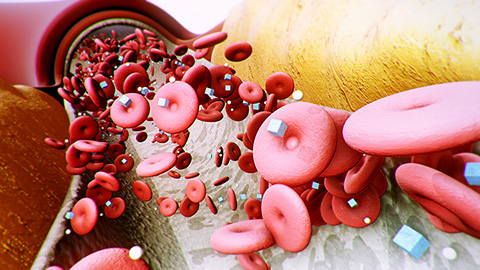Lipid profiles reveal sex differences in type 2 diabetes
Type 2 diabetes, or T2D, is a metabolic disorder that affects global communities disproportionally. For example, South Asians face a particularly high risk. Changes in lipid species affect T2D, but scientists have not identified any reliable lipid biomarkers. Fatty acids, or FAs, are the major components of many lipids, and they can be potential lipid biomarkers. However, conflicting findings have left unclear how essential FAs relate to T2D development.

In a recent study in the Journal of Lipid Research, Madhusmita Rout and a team of researchers at the University of Oklahoma Health Sciences Center investigated the lipid profiles of individuals from a well-characterized cohort of Asian Indians. They found that in T2D, levels of two key cell membrane components — sphingomyelin and phosphatidylcholines — decreased, while free FAs and lysophosphatidylcholines, or LPCs, increased. After adjusting for age, sex and body mass index, or BMI, they saw significant increases in several essential FAs, such as the omega-6 FA arachidonic acid and the omega-3 FA docosahexaenoic acid. However, in obese individuals, most omega-3 and omega-6 FAs were reduced two- to six-fold. The team also observed sex- and age-related lipid differences. For example, one LPC type was elevated in men of all ages but rose in women only after menopause.
Ultimately, this study identified potentially useful lipid biomarkers that could possibly affect the development of T2D and obesity. Future directions include clarifying the relationship between omega FAs and T2D, as well as the role of essential FAs in human metabolic diseases.
Enjoy reading ASBMB Today?
Become a member to receive the print edition four times a year and the digital edition monthly.
Learn moreGet the latest from ASBMB Today
Enter your email address, and we’ll send you a weekly email with recent articles, interviews and more.
Latest in Science
Science highlights or most popular articles

Gut microbes hijack cancer pathway in high-fat diets
Researchers at the Feinstein Institutes for Medical Research found that a high-fat diet increases ammonia-producing bacteria in the gut microbiome of mice, which in turn disrupts TGF-β signaling and promotes colorectal cancer.

Mapping fentanyl’s cellular footprint
Using a new imaging method, researchers at State University of New York at Buffalo traced fentanyl’s effects inside brain immune cells, revealing how the drug alters lipid droplets, pointing to new paths for addiction diagnostics.

Designing life’s building blocks with AI
Tanja Kortemme, a professor at the University of California, San Francisco, will discuss her research using computational biology to engineer proteins at the 2026 ASBMB Annual Meeting.

Cholesterol as a novel biomarker for Fragile X syndrome
Researchers in Quebec identified lower levels of a brain cholesterol metabolite, 24-hydroxycholesterol, in patients with fragile X syndrome, a finding that could provide a simple blood-based biomarker for understanding and managing the condition.

How lipid metabolism shapes sperm development
Researchers at Hokkaido University identify the enzyme behind a key lipid in sperm development. The findings reveal how seminolipids shape sperm formation and may inform future diagnostics and treatments for male infertility.

Mass spec method captures proteins in native membranes
Yale scientists developed a mass spec protocol that keeps proteins in their native environment, detects intact protein complexes and tracks drug binding, offering a clearer view of membrane biology.

